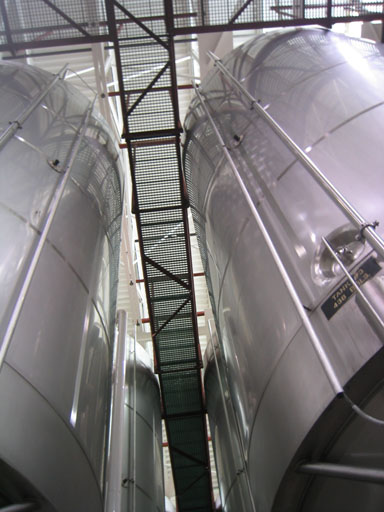The production of Single Cell Protein can be done by using waste materials as the substrate, specifically agricultural wastes such as wood shavings, sawdust, corn cobs, and many others. Examples of other waste material substrates are food processing wastes, residues from alcohol production, hydrocarbons, or human and animal excreta.
The process of SCP production from any microorganism or substrate would have the following basic steps:
The process of SCP production from any microorganism or substrate would have the following basic steps:
- Provision of a carbon source; it may need physical and/or chemical pretreatments.

Large scale biomass fermenter - Addition, to the carbon source, of sources of nitrogen, phosphorus and other nutrients needed to support optimal growth of the selected microorganism.
- Prevention of contamination by maintaining sterile or hygienic conditions. The medium components may be heated or sterilized by filtration and fermentation equipments may be sterilized.
- The selected microorganism is inoculated in a pure state.
- SCP processes are highly aerobic (except those using algae). Therefore, adequate aeration must be provided. In addition, cooling is necessary as considerable heat is generated.
- The microbial biomass is recovered from the medium.
- Processing of the biomass for enhancing its usefulness and/or storability.
The selection of certain microbial strain is very important, some of the criteria are:
- Performance (growth rate, productivity, yield) on the specific. preferably low-cost substrates to be used
- Temperature and pH tolerance
- Oxygen requirements, heat generation during fermentation and foaming characteristics
- Growth morphology and genetic stability in the fermentation
- Ease of recovery, and requirements for further downstream processing
- Structure and composition of the final product, in terms of protein
 |
| Small scale biomass production |
It has been calculated that 100 lbs of yeast will produce 250 tons of proteins in 24 hours, whereas a 1000 lbs steer will synthesize only 1 lb of protein 24 hours and this after consuming 12 to 20 lbs of plant proteins. Similar, algae grown in ponds can produce 20 tons (dry weight) of protein, per acre, per year.
However, the main problem of SCP production is the relatively high cost in the downstream processing and marketing SCP as food. Using waste materials as substrate provides lower yield of biomass than using more defined substrates, many processes are required to increase the biomass concentrations including centrifugation, flotation, precipitation, coagulation and filtration, or the use of semi-permeable membranes. SCP also treated with other processes to kill the microbes, increase the digestibility, and to reduce the nucleic acid content. These processes require extra costs which may exceed the costs for conventional food production. The removal or reduction of nucleic acid content of various SCP's is achieved with one of the following treatments:
- chemical treatment with NaOH;
- treatment of cells with 10% NaCl;
- thermal shock.
These methods aim to reduce the RNA content from about 7% to 1% which is considered within acceptable levels.
Microorganism and substrates used for single cell protein production have been outlined in the table below:
By : Adrian & Kishan
References
Srivastava, M.L., (2008), Fermentation Technology, Alpha Science International, Oxford
Trehan, K., (1990), Biotechnology, New Age International, New Delhi
References
Srivastava, M.L., (2008), Fermentation Technology, Alpha Science International, Oxford
Nasseri, A., Rasoul-Amini, S., Morowvat, M. & Ghasemi, Y. (2010) Single Cell Protein: Production and Process. American Journal of Food Technology, 6, p.pp.103-116.
Trehan, K., (1990), Biotechnology, New Age International, New Delhi


Speaking of single cell protein, we have to say something about single protein production (SPP)TM technology. It is developed for high-throughput protein production. In the SPP system, live E. coli cells are converted into a bioreactor producing only a single protein of interest in a high yield. A yield of 20–30% of total cellular protein can be obtained with our technology, which overwhelms all protein production methods known so far. Learn more about single protein production technology.
ReplyDeletehow much will it cost for to start SCP production plant
ReplyDeletegood and well- researched article with very relevant references to prove the point of study. It is quite helpful for the students who wants to get more information about the topic.
ReplyDelete